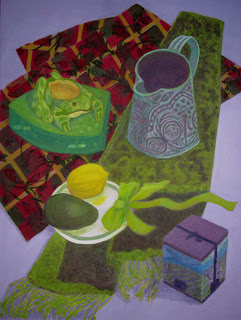
"All artists have accidents, and the better the artist, the better the accident." Did I read this somewhere? Did someone actually say it? Or did I invent it as I lurched from one accident, mistake or oversight to another in the production of my Feb-March painting, "The Improbable Pond"?
My first accident was to pursue it at all, once I'd assembled the set-up. Viewed with caution, it seemed even at that stage to present some problems. But then I remembered the words of one of my esteemed role models, Mary Beth McKenzie. She and my other favorite, Harriet Shorr, are women in their 70's now, enduringly successful NYC-based artists, who in their student days bucked the art school trend in abstraction and have continued to paint in a representational manner (where things look like the things they are). I return again and again to their books and their thoughts about the process of art and about being an artist. Mary Beth writes (in A PAINTERLY APPROACH):
Growth for an artist is generally slow and unconscious. Real progress takes place over a long period of time....Unless you approach painting with a highly experimental attitude and are willing to take risks with your work, your progress will be extremely slow. It's important to continually challenge yourself, to set up problems for yourself in order to develop your technique and to experiment with new ideas. Vary your approach: try different mediums, different sized canvases, unusual points of view, more ambitious compositions. Always try to extend your reach. In this way, your work will continue to change and develop naturally. You must evolve as an artist, and this is really a lifelong process.
With her counsel in mind, I took a deep breath and leaped into "The Improbable Pond." I think I've been moderately successful in bringing it all together although the outcome is different from what I'd originally expected I would do with it. The sequence of its development is charted (can I say "by popular demand"?) at this Picasa link. Go ahead. Take the plunge.



